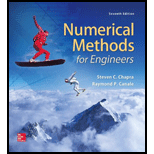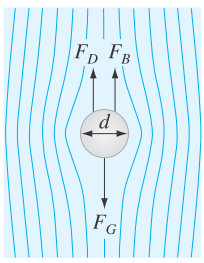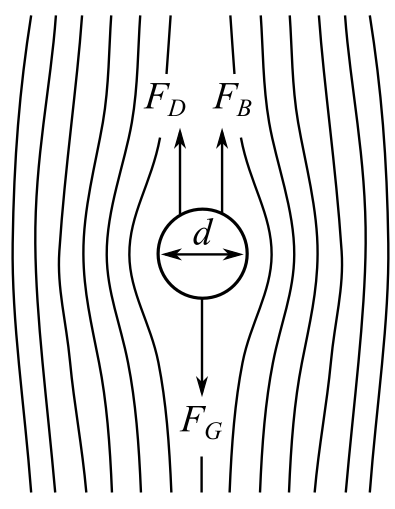
Concept explainers
As depicted in Fig. P1.22, a spherical particle settling through a quiescent luid is subject to three forces: the downward force of gravity
where
(a) Use a force balance for the particle to develop the differential equation for
(b) At steady-state, use this equation to solve for the particle's terminal velocity.
(c) Employ the result of (b) to compute the particle's terminal velocity in m/s for a spherical silt particle settling in water:
(d) Check whether low is laminar.
(e) Use Euler's method to compute the velocity from

FIGURE P1.22
(a)
The differential equation for
Answer to Problem 22P
Solution:
The differential equation for
Explanation of Solution
Given Information:
The drag force is given as
Where,
The mass of the particle,
The mass of the displaced fluid,
The volume of sphere is
The figure,

From the provided figure, the drag force and buoyancy force are against the gravitational force.
Therefore, the force balance on the sphere is given as,
Here,
And,
And,
And,
Thus, the force balance on the sphere is,
Divide the both sides of the above equation by m,
Now, the mass of the particle
Substitute
The volume of the sphere is
Substitute
Hence, the differential equation for
(b)
The particle’s terminal velocity at the steady state by the use of the differential equation
Answer to Problem 22P
Solution:
The particle’s terminal velocity at the steady state is
Explanation of Solution
Given Information:
The differential equation
At the steady state, the change in the velocity is zero. Therefore,
Now, solve the above equation for particle’s terminal velocity v as below,
Simplify furthermore,
Hence, the particle’s terminal velocity at the steady state is,
(c)
To calculate: The value of particle’s terminal velocity in m/secif the particle’s terminal velocity is given as
Answer to Problem 22P
Solution:
The value of particle’s terminal velocity in m/sec is
Explanation of Solution
Given Information:
The particle’s terminal velocity is given as
The values,
Formula used:
The conversions,
Calculation:
The particle’s terminal velocity at the steady state is,
Convert the provided values in to the required units as below,
And,
And,
And,
Substitute
Simplify furthermore,
Hence, the value of the particle’s terminal velocity in m/sec is
(d)
Whether the flow is laminar or not if the Reynolds number is given as
Answer to Problem 22P
Solution:
The flow is laminar.
Explanation of Solution
Given Information:
The Reynolds number is given as
The values,
The flow is laminar if the value of Reynolds number is less than 1.
Now, consider the Reynolds number as,
From part (c),
And,
Substitute the values
Since, the Reynolds number is less than 1.
Hence, the flow is laminar.
(e)
To calculate: The velocity from
Answer to Problem 22P
Solution:
The velocity from
| t | v | dv/dt |
| 0 | 0 | 6.10771 |
| 3.8147E-06 | 2.32991E-05 | 3.891969 |
| 7.6294E-06 | 3.81457E-05 | 2.480049 |
| 1.1444E-05 | 4.76064E-05 | 1.580343 |
| 1.5259E-05 | 5.36349E-05 | 1.00703 |
| 1.9073E-05 | 5.74764E-05 | 0.641702 |
| 2.2888E-05 | 5.99243E-05 | 0.408907 |
| 2.6703E-05 | 6.14842E-05 | 0.260564 |
| 3.0518E-05 | 6.24782E-05 | 0.166037 |
Explanation of Solution
Given Information:
The values,
The initial condition
Formula used:
Euler’s method for
Where, h is the step size.
Calculation:
From part (a), the differential equation is,
Convert the provided values in to the standard MKS units as below,
And,
And,
And,
Substitute
The iteration formula for Euler’s method with step size
Use excel to find all the iteration with step size
Step 1: Name the column A as t and go to column A2 and put 0 then go to column A3and write the formula as,
=A2+2^(-18)
Then, Press enter and drag the column up to the
Step 2: Now name the column B as v and go to column B2 and write 0 and then go to the column B3 and write the formula as,
=B3+2^(-18)*(6.10771-95100*B3)
Step 3: Press enter and drag the column up to the
Step 4. Now name the column C as dv/dt and go to column C2 and write the formula as,
=6.10771-95100*B2
Step 5. Press enter and drag the column up to the
Thus, all the iterations are as shown below,
| t | v | dv/dt |
| 0 | 0 | 6.10771 |
| 3.8147E-06 | 2.32991E-05 | 3.891969 |
| 7.6294E-06 | 3.81457E-05 | 2.480049 |
| 1.1444E-05 | 4.76064E-05 | 1.580343 |
| 1.5259E-05 | 5.36349E-05 | 1.00703 |
| 1.9073E-05 | 5.74764E-05 | 0.641702 |
| 2.2888E-05 | 5.99243E-05 | 0.408907 |
| 2.6703E-05 | 6.14842E-05 | 0.260564 |
| 3.0518E-05 | 6.24782E-05 | 0.166037 |
Want to see more full solutions like this?
Chapter 1 Solutions
INTERNATIONAL EDITION---Numerical Methods for Engineers, 7th edition
Additional Math Textbook Solutions
Advanced Engineering Mathematics
Basic Technical Mathematics
Fundamentals of Differential Equations (9th Edition)
College Algebra Essentials
Calculus Early Transcendentals, Binder Ready Version
 Algebra and Trigonometry (MindTap Course List)AlgebraISBN:9781305071742Author:James Stewart, Lothar Redlin, Saleem WatsonPublisher:Cengage Learning
Algebra and Trigonometry (MindTap Course List)AlgebraISBN:9781305071742Author:James Stewart, Lothar Redlin, Saleem WatsonPublisher:Cengage Learning College AlgebraAlgebraISBN:9781305115545Author:James Stewart, Lothar Redlin, Saleem WatsonPublisher:Cengage Learning
College AlgebraAlgebraISBN:9781305115545Author:James Stewart, Lothar Redlin, Saleem WatsonPublisher:Cengage Learning Mathematics For Machine TechnologyAdvanced MathISBN:9781337798310Author:Peterson, John.Publisher:Cengage Learning,
Mathematics For Machine TechnologyAdvanced MathISBN:9781337798310Author:Peterson, John.Publisher:Cengage Learning,


